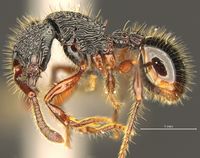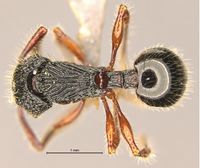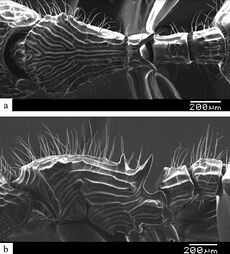Myrmecina magnificens
| Myrmecina magnificens | |
|---|---|

| |
| Scientific classification | |
| Kingdom: | Animalia |
| Phylum: | Arthropoda |
| Class: | Insecta |
| Order: | Hymenoptera |
| Family: | Formicidae |
| Subfamily: | Myrmicinae |
| Tribe: | Crematogastrini |
| Genus: | Myrmecina |
| Species complex: | spinosa |
| Species: | M. magnificens |
| Binomial name | |
| Myrmecina magnificens Wong & Guénard, 2016 | |
This species has been found in lowland primary forest.
Identification
Okido, Ogata, and Hosoishi (2020) - Okido, Ogata, and Hosoishi (2020) - A member of the Myrmecina spinosa complex. Among these species, M. magnificens can be distinguished by the combination of a concave anterior margin of the first gastral tergum, bent masticatory margin of the mandible, and a strongly elevated propodeal spine.
Wong and Guénard (2016) - With the exception of Myrmecina sulcata for which body size was not recorded in the species description, the new species M. magnificens can quickly be distinguished from other Myrmecina species in the Sundaland region by its large overall size (TL 4.2–4.6 mm) and its distinctly long and forward-pointing propodeal spines. While Myrmecina nesaea, Myrmecina semipolita, M. sulcata and Myrmecina undulata also possess relatively long propodeal spines, their spines are posteriorly oriented. The other two species, Myrmecina bandarensis and Myrmecina butteli have relatively short propodeal spines, and are also notably smaller in their overall sizes (TL 1.9–2.2 mm), which by comparison would be approximately half that of M. magnificens.
Keys including this Species
Distribution
Latitudinal Distribution Pattern
Latitudinal Range: 1.395141° to 1.395141°.
| North Temperate |
North Subtropical |
Tropical | South Subtropical |
South Temperate |
- Source: AntMaps
Distribution based on Regional Taxon Lists
Indo-Australian Region: Indonesia, Malaysia, Singapore (type locality).
Distribution based on AntMaps
Distribution based on AntWeb specimens
Check data from AntWeb
Countries Occupied
| Number of countries occupied by this species based on AntWiki Regional Taxon Lists. In general, fewer countries occupied indicates a narrower range, while more countries indicates a more widespread species. |

|
Estimated Abundance
| Relative abundance based on number of AntMaps records per species (this species within the purple bar). Fewer records (to the left) indicates a less abundant/encountered species while more records (to the right) indicates more abundant/encountered species. |

|
Biology
All specimens were collected from a selectively logged lowland primary rainforest. Based on the collection methods used to collect several workers (N=5), we suspect that M. magnificens probably forages within the leaf litter and topsoil. This is based on our collection of the species via a Berlese extraction of sifted leaf litter and topsoil, as well as from a subterranean pitfall trap baited with tuna and buried at a depth of 5 cm underground. No other conspecifics were found in similar traps buried at greater depths (i.e. 15, 20, 25 cm) within the same locality.
The apparent abundance of this species within Seletar forest is surprising; thus far several specimens have been collected with a variety of methods including Berlese extractions of understorey material as well as baited subterranean pitfall traps. In conclusion, the present discovery of a new ant species that is non-cryptic, of relatively large body size (TL > 4 mm) and perhaps not uncommon in a small forest remnant (ca. 2000 ha) of a highly urbanized city (i.e. Singapore) clearly highlights the shortage of extensive sampling in Southeast Asia, and is very encouraging to future myrmecological research in this part of the world.
Okido, Ogata, and Hosoishi (2020) - Ergatogynes are present in the species, and only distinguished from the workers in width and length of the first gastral tergum (Ito, 1996). The species inhabits in rotten branches (Ito, pers. comm.) and litter.
Castes
Worker
Nomenclature
The following information is derived from Barry Bolton's Online Catalogue of the Ants of the World.
- magnificens. Myrmecina magnificens Wong & Guénard, 2016: 132, figs. 1-5 (w.) SINGAPORE.
Unless otherwise noted the text for the remainder of this section is reported from the publication that includes the original description.
Description
Worker
Holotype: HL 0.98 mm; HW 1.12 mm; MaL 0.63 mm; SL 0.90 mm; EL 0.20 mm; WL 1.37 mm; PNW 0.71 mm; PNH 0.62 mm; MW 0.65 mm; PSL 0.24 mm; PTL 0.36 mm; PTW 0.32 mm; PTH 0.35 mm; TL 4.42 mm (stinger not included); PPL 0.23 mm; PPW 0.34 mm; PPH 0.39 mm; CI 114, SI 80, MaI 56, PI 88, PPI 149.
Paratypes (n=4): HL 0.94–0.98 mm; HW 1.06–1.11 mm; MaL 0.55–0.63 mm; SL 0.89–0.91 mm; EL 0.20–0.21 mm; WL 1.22–1.36 mm; PNW 0.70–0.74 mm; PNH 0.57–0.62 mm; MW 0.61–0.65 mm; PSL 0.23–024 mm; PTL 0.34–0.36 mm; PTW 0.29–0.31 mm; PTH 0.31–0.33 mm; TL 4.36–4.57 mm (stinger not included); PPL 0.22–0.24 mm; PPW 0.32–0.35 mm; PPH 0.34–0.36 mm; CI 113–116, SI 80–86, MaI 51–57, PI 83–87, PPI 141–151.
Head. Head in full-face view slightly shorter than wide (CI 113–116) and maximum HW occurs behind the eyes, sides convex, occipital corners triangular, occipital margin strongly convex. Thin lamella finely rugulose present on the anterolateral margin of the clypeus. Eyes relatively large with EL approximately 1/5 of HL. Antennal scape long (SI 80–86); antenna with 12 segments, last three segments forming indistinct club. Clypeus short, anterior clypeal margin broadly convex with two angular projections on either sides. Mascitory margin of mandible with two apical teeth followed by a series of extremely reduced blunt denticles (n=5).
Mesosoma. In profile view, dorsal outline of promesonotum flat to broadly convex, sloping along anterodorsal part of propodeum. In profile view, propleuron angular and forming a distinct acute tooth. Two distinct propodeal spines both slightly longer than broad and pointing anteriorly. Propodeal declivity strongly concave before terminating at a right angle with a rounded edge.
Metasoma. In profile view, anterodorsal face of petiolar node broadly convex, posterodorsal face of petiolar node flat to weakly concave; overall dorsal outline of petiolar node triangular. Ventral outline of petiolar node rounded. Dorsal outline of postpetiole flat to weakly convex, sternopostpetiolar process well-developed and triangular, almost as long as broad and pointing anteriorly. Petiolar node is longer than postpetiole. In dorsal view, petiolar node is broader than long and exhibits trapezoid shape; petiolar node is distinctly broader at posterior margin than at anterior margin. Postpetiole is broader than long and exhibits rectangular shape; width of post-petiole is similar at both the anterior and posterior margins.
Sculpture. Sculpturing on head and thorax running longitudinally. Sculpture on head parallel on its middle portion and divergent on the sides and posterior portions. Groove on head with latitudinal sculptures present on most of its length. In profile view, sculpture on thorax presenting a complex pattern with parallel or and convergent sculptures. Parallel sculptures present on the entire length of the petiole and postpetiole. Gaster smooth and shiny. In dorsal view, thorax entirely sculptured with a single median carina separating in two symmetrical portions the dorsal sculptures. Other sculptures converging posteriorly to reach the median carina on the dorsum of the thorax.
Pubescence. Almost all of body covered in abundant erect long hairs (0.2–0.25 mm) with the exception of the propodeal junction and ventral surface of the petiole where pubescence is absent.
Coloration. Most of head, mesosoma and gaster black; antenna, clypeus and mandibles dark red to dark brown; legs, posterior portion of propodeum light amber to light brown; pubescence and margins of gastral tergites yellow to light gold.
Okido, Ogata, and Hosoishi (2020) - Workers. TL 4.02-4.26, HL 1.08-1.13, HW 1.06-1.09, CI 96-99, SL 0.93-1.01, SI 87-93, PW 0.69, ML 1.10-1.14 (5 measured).
Occipital margin strongly concave in full-face view; occipital corners projected posteriorly. Masticatory margin of mandible straight; apical tooth strong, third tooth acute, followed by 6 small but distinct teeth. Dorsal surface of clypeus concave; median portion of anterior margin weakly projected, without a median process; lateral portion without a sharp ridge of shield wall, but weakly carinate on each side, in front of antennal insertions. Anterior dorsal surface of labrum with paired small denticles, close to each other without fusion. Frontal carinae present, running to near occipital corners but frequently unclear. Eyes large and convex, varying in size with maximum diameter 0.18-0.20 mm and 8-10 ommatidia; malar space longer than diameter of eye in profile. Antennal scape just reaching posterolateral corner of head; antennal flange developed.
Dorsal outline of mesosoma slightly convex in profile. Pronotum with two or four small denticles on anterior dorsolateral portion in dorsal view, but frequently unclear; anterior ventrolateral portion with small denticle directing forward and downward but varying in shape and direction; frequently not forming denticle but angulately. Eumetanotal spine long with acute apex. Propodeal spine elongate, variable in length, strongly curved upward. Propodeal lobe low. Propodeal spiracle situated near base of propodeal spine, distance between posterior margin of spiracle and posterior margin of propodeum longer than diameter of spiracle. Petiole short, almost as long as high in profile; small dorsal crest located anterioriy in profile; subpetiolar process triangular but variable; ventral outline flattened. Postpetiole almost as broad as petiole and expanded posteriorly in dorsal view; lateral portion not marginated; dorsal outline slightly convex in profile; ventral outline projected at anterior portion.
Anterior margin of gaster concave in dorsal view.
Head with weakly waved rugae which are thick and longitudinal; ventrolateral portion usually with longitudinal rugae which are curved at posterior portion. Mandibles sometimes with reddish brown spots on dorsal surface clearly. Clypeus smooth and shining. Mesosoma with weakly waved rugae which are thick and longitudinal; lateral portion with weakly waved rugae which are thick. Petiole and postpetiole with a few longitudinal rugae. First gastral tergum smooth and shining. Head and mesosoma with long pilosity on dorsum. Pilosity of pronotum as long as propodeal spines or longer. Head, mesosoma, petiole and postpetiole black, legs varying from yellowish brown to light reddish brown, forecoxae varying from reddish brown to black, gaster reddish brown.
Type Material
Holotype. Worker from SINGAPORE, Seletar Trail, Central Catchment Nature Reserve, 1.395141°N, 103.802595°E, 47m, 02.IX.2015, leaf litter, leg. Mark K. L. Wong, label “MW020915-L1.1” (ANTWEB1009004) deposited in Lee Kong Chian Natural History Museum. Paratypes. Four workers in total (ANTWEB1009005, ANTWEB1009006, ANTWEB1009007, ANTWEB1009008), all with the same collection data as holotype (deposited at Insect Biodiversity and Biogeography Laboratory).
Etymology
The species epithet is derived from the English word ‘magnificent’, referencing the beautiful appearance of this species, which makes it truly magnificent to behold. The species epithet is a noun, and thus invariant.
References
- Okido, H., Ogata, K., Hosoishsi, S. 2020. Taxonomic revision of the ant genus Myrmecina in Southeast Asia (Hymenoptera: Formicidae). Bulletin of the Kyushu University Museum 7, 1-108.
- Satria, R., Eguchi, K. 2022. A new species of the genus Myrmecina Curtis, 1829 (Formicidae: Myrmicinae) from Sumatra. Far Eastern Entomologist, 463, 1–7 (doi:10.25221/fee.463.1).
- Wang, W.Y., Soh, E.J.Y., Yong, G.W.J., Wong, M.K.L., Benoit Guénard, Economo, E.P., Yamane, S. 2022. Remarkable diversity in a little red dot: a comprehensive checklist of known ant species in Singapore (Hymenoptera: Formicidae) with notes on ecology and taxonomy. Asian Myrmecology 15: e015006 (doi:10.20362/am.015006).
- Wong, M.K.L. & Guénard, B. 2016. First record of the ant genus Myrmecina from the Malay Peninsula: description of a new species and a key to Myrmecina species from Sundaland. Journal of Hymenoptera Research. 50:129-140.





